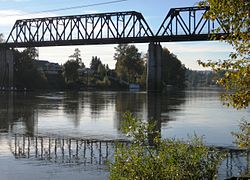- Wilsonville railroad bridge
-
Wilsonville railroad bridge Carries Portland and Western Railroad Crosses Willamette River Locale Wilsonville, Oregon Maintained by Portland and Western Railroad Design Thru truss bridge Total length 1,220 feet (370 m) Longest span 500 feet (150 m) Opened 1975 Coordinates 45°17′35″N 122°46′35″W / 45.292928°N 122.776487°WCoordinates: 45°17′35″N 122°46′35″W / 45.292928°N 122.776487°W The Wilsonville railroad bridge is a steel truss bridge that crosses the Willamette River at Wilsonville, Oregon, United States. This 1,220-foot (370 m) long structure was finished in 1975 to replace a 1907 bridge at the same location and carries rail traffic for the Portland and Western Railroad. The original bridge was built to carry the Oregon Electric Railway across the river near the Boones Ferry.
Contents
History
The first bridge was built in 1907 for the Oregon Electric Railway line that ran from Eugene to Portland.[1] That bridge was a steel, 2,430-foot (740 m) long structure slightly downriver from the Boones Ferry crossing at a section of the Willamette that runs east-west between Canby and Newberg.[1] Known as the Oregon Electric Wilsonville Bridge, the bridge had a southern approach consisting of a wooden trestle measuring more than 2,600 feet (790 m) in length.[2] This trestle caught fire in July 1939.[3]
In 1954, the ferry was discontinued when the Boone Bridge opened to carry U.S. Route 99, now Interstate 5. Ownership of the rail bridge passed to the Spokane, Portland and Seattle Railway in 1910, and in 1970 it became part of the new Burlington Northern Railroad (BN).
In 1972, initial plans for a new bridge were approved by the Coast Guard and construction began on August 1, 1973.[4] Hensel Phelps Construction Company built the new bridge for Burlington Northern, which included constructing new piers in the river.[4] The bridge was completed in July 1975, and opened for rail traffic on August 6, 1975.[4] The rail line was leased to Portland and Western in 1995,[4] which they then bought the tracks in 1997.[5] The land and bridges underneath the tracks of the line were donated to the state by Burlington Northern in 1998.[5][6]
Details
Located upstream from the old ferry landings, the bridge is at river mile 38.8.[7] Built of two steel thru trusses each 250 feet (76 m) long, the total span is 1,220 feet (370 m) long.[4] This type of truss allowed the new bridge to sit lower than the previous bridge, as the bridge's structure sat above the tracks, whereas the old bridge's girders were located below the track level, and thus the entire bridge needed to be higher in order to allow river traffic to pass.[4] The old bridge stood 120 feet (37 m) tall.[8]
The structure is supported by four concrete piers in the river, three piers on land, and two abutments.[4] Carrying a single track on a concrete deck, the bridge includes six 120-foot-long (37 m) deck girder spans used on the approaches.[4] The black-colored bridge was designed and built by Hensel Phelps Construction.[4] Constructed of weathering steel, the bridge superstructure is oxidized, which prevents rust.[4] It also means the bridge does not need to be painted.[4]
References
- ^ a b Robertson, Donald B. 1986. Encyclopedia of Western Railroad History. Caldwell, Idaho: Caxton Printers, p. 109.
- ^ DuBois, Donald (1999). "Construction Views of the Oregon Electric Wilsonville Bridge". The Northwest's Own Railway (Spokane, Portland & Seattle Railway Historical Society) (1): 10–12.
- ^ "Oregon Electric Railway Bridge of fire". Aden Digital Image Collection. Wilsonville-Boones Ferry Historical Society. http://aden.wilsonvillelibrary.org/web-content/r03.html. Retrieved 2009-09-29.
- ^ a b c d e f g h i j k Perry, Sheldon (2001). "The new Oregon Electric bridge at Wilsonville". The Northwest's Own Railway (Spokane, Portland & Seattle Railway Historical Society) (2): 6–9.
- ^ a b McCamish, Brian. "Portland & Western". Active & Abandoned Railroads of the Pacific Northwest. http://www.brian894x4.com/PortlandandWesternRR.html. Retrieved 2009-09-29.
- ^ Gamm, Joe (July 2, 2009). "Whose bridge is it anyway?". The Daily Astorian.
- ^ 2007 D13 Bridge Inspection list as of 30 Nov 07. United States Coast Guard. Retrieved 2008-07-13.
- ^ "Trestle bridge and crane". Aden Digital Image Collection. Wilsonville-Boones Ferry Historical Society. http://aden.wilsonvillelibrary.org/web-content/r07.html. Retrieved 2009-09-29.
External links
- Picture of original bridge
- Steamboat passing the original bridge
- Structurae
- Picture of construction on the original bridge
Crossings of the Willamette River Upstream
Oregon Route 219 bridge

Wilsonville railroad bridge Downstream
Boone Bridge
 Categories:
Categories:- Wilsonville, Oregon
- Bridges completed in 1975
- Bridges in Clackamas County, Oregon
- Bridges over the Willamette River
- Railroad bridges in Oregon
Wikimedia Foundation. 2010.

